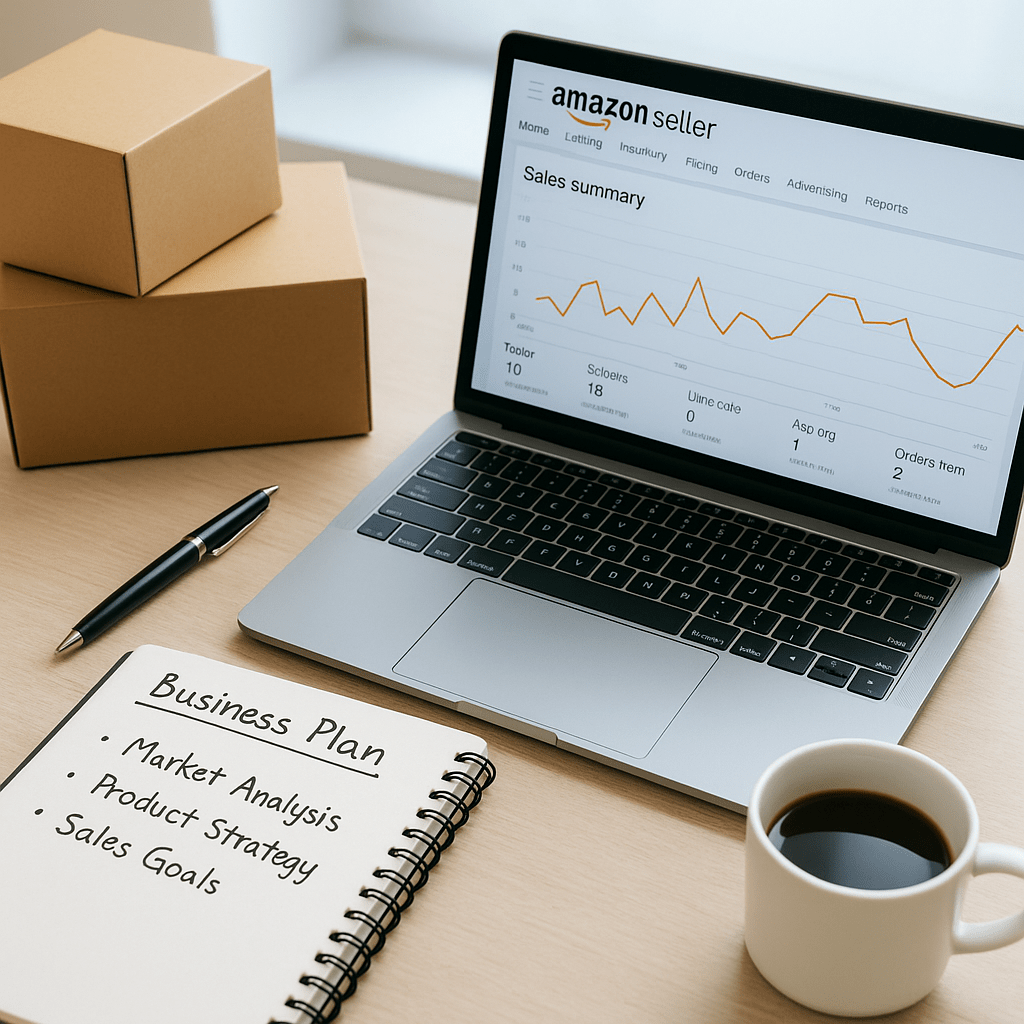Amazon PPC Campaign for Beginners: Step-by-Step Guide
Amazon PPC Campaign for Beginners: Step-by-Step Guide
Introduction:
If you’re an Amazon seller, you’ve probably realized that simply listing a product isn’t enough anymore. With millions of sellers competing on the marketplace, visibility has become the deciding factor between products that sell and products that remain hidden. This is where Amazon PPC Campaigns come in.
Amazon’s Pay-Per-Click (PPC) advertising system allows sellers to bid for ad placements on the marketplace. When shoppers search for relevant keywords, your ad can appear at the top of search results or directly on competitor listings. Unlike traditional ads, you only pay when someone clicks on your Amazon PPC ad, making it one of the most cost-effective ways to generate visibility and sales.
In this comprehensive guide (yes, over 7500 words!), we’ll break down everything you need to know about launching your first Amazon PPC campaign—from understanding the basics to advanced strategies for scaling. Whether you’re a beginner seller or a small business owner in the USA aiming to build a brand presence, this guide will help you confidently take the first step.
Table of Contents:
- What is Amazon PPC?
- Benefits of Running Amazon Campaigns
- Types of Amazon PPC Campaigns
- Preparing Before Launching Your Campaign
- Step 1: Setting Up Your First Amazon PPC Campaign
- Step 2: Choosing Between Automatic and Manual Campaigns
- Step 3: Crafting a Winning Amazon PPC Campaign Strategy
- Step 4: Managing Amazon PPC for Long-Term Success
- Step 5: Using Amazon PPC for Variations and Product Testing
- Amazon PPC Campaign Management Best Practices
- Scaling Your PPC Amazon Campaign
- Advanced Amazon PPC Strategies
- Common Mistakes Sellers Make
- Case Studies: Beginner to Advanced PPC Success
- Tools and Software for Amazon PPC Campaign Management
- Understanding Key Metrics: ACoS, TACoS, CTR & CVR
- Budgeting and Bidding Strategies for Amazon PPC
- Optimizing Product Listings for Better Ad Results
- Seasonal Campaign Strategies
- Final Tips for Beginners
- Conclusion
- Faqs
What is Amazon PPC?
Amazon PPC (Pay-Per-Click) is Amazon’s in-house advertising model where sellers and brands promote their products by bidding on keywords or placements. When a shopper clicks your ad, you pay a small fee to Amazon. The goal? To drive traffic, increase visibility, and improve your organic ranking over time.
There are three main ad formats within the PPC Amazon campaign system:
- Sponsored Products – Ads tied to individual product listings.
- Sponsored Brands – Ads that highlight your brand and multiple products.
- Sponsored Display – Ads that appear both on Amazon and across partner websites.
For beginners, Sponsored Products are the most straightforward and effective way to get started.
Benefits of Running Amazon Campaigns:
Running an Amazon PPC campaign isn’t just about quick sales—it plays a larger role in your overall Amazon business strategy.
- Increased Visibility: Ads place your product in front of more shoppers.
- Boost Organic Ranking: Sales generated from ads help your product rank higher in organic search results.
- Brand Awareness: Sponsored Brands campaigns showcase your logo and product portfolio.
- Targeted Advertising: You control who sees your ads through keyword and product targeting.
- Data-Driven Insights: Campaign reports help refine listings, pricing, and future ad spend.
Think of PPC as fuel for your Amazon growth engine. Without it, organic ranking becomes painfully slow.
| Campaign Type | Best For | Control | Placement | Cost |
|---|---|---|---|---|
| Sponsored Products | Boosting sales of individual listings | Medium | Search results, product detail pages | $ – $$ |
| Sponsored Brands | Brand awareness and showcasing multiple products | High | Top of search results, brand store | $$ – $$$ |
| Sponsored Display | Retargeting and competitor product targeting | Medium | On and off Amazon placements | $$ – $$$ |
Types of Amazon PPC Campaigns:
Let’s break down each campaign type in detail.
Sponsored Products:
- Appear directly in Amazon search results.
- Easy to set up.
- Ideal for driving sales of individual listings.
Sponsored Brands:
- Display brand name, logo, and multiple products.
- Great for building brand recognition.
- Usually more effective once you have multiple SKUs.
Sponsored Display:
- Allows targeting audiences beyond search (retargeting shoppers who viewed your product).
- Expands reach beyond Amazon’s platform.
Each type plays a role in a complete Amazon PPC campaign strategy, but beginners should focus on Sponsored Products first.
Preparing Before Launching Your Campaign:
Before you dive into ads, preparation is crucial. Running ads without groundwork is like pouring water into a leaking bucket.
Here’s what to do:
- Optimize Your Listings: Product images, titles, bullet points, and descriptions must be compelling and keyword-rich.
- Keyword Research: Tools like Helium 10, Jungle Scout, or even Amazon’s search bar can help identify profitable keywords.
- Budget Planning: Decide how much you can afford daily. Most beginners start with $20–$30.
- Competitor Analysis: Study top-ranking competitors’ titles, keywords, and reviews.
Preparation ensures that your Amazon PPC ads convert once traffic flows in.

Step 1: Setting Up Your First Amazon PPC Campaign:
Here’s a quick step-by-step guide to launch your very first campaign:
- Log into Seller Central.
- Go to Advertising → Campaign Manager.
- Select “Create Campaign.”
- Choose Sponsored Products.
- Set campaign name, daily budget, and duration.
- Add your product(s).
- Select targeting type (automatic or manual).
- Adjust bidding strategy.
- Launch your campaign.
That’s your first Amazon PPC campaign live!
Step 2: Choosing Between Automatic and Manual Campaigns
Automatic Campaigns
- Amazon decides which keywords to target.
- Ideal for beginners and keyword discovery.
- Easy setup, low effort.
Manual Campaigns
- You choose exact keywords and match types (broad, phrase, exact).
- Provides more control.
- Better for scaling and optimization.
Most sellers run both types simultaneously. Start with auto campaigns, then transfer profitable keywords into manual campaigns.
Step 3: Crafting a Winning Amazon PPC Campaign Strategy
Your Amazon PPC strategy is what makes the difference between wasted spend and profitable ads.
Key elements:
- Use auto campaigns for discovery.
- Transfer converting keywords into manual campaigns.
- Apply negative keywords to block irrelevant clicks.
- Test different bid levels and placements.
- Monitor ACoS and TACoS closely.
Internal cross-link suggestions:
- [Amazon Keyword Research Guide]
- [ACoS Optimization Tips]
[Product Listing Optimization Best Practices]
Step 4: Managing Amazon PPC for Long-Term Success
To manage Amazon PPC campaigns properly, you must:
- Regularly analyze campaign reports.
- Cut wasted spend by pausing poor-performing keywords.
- Reallocate budget toward top performers.
- Optimize bids weekly.
- Test different ad placements.
Effective Amazon PPC campaign management means treating it as an ongoing process—not a one-time setup.
Step 5: Using Amazon PPC for Variations and Product Testing:
If you sell multiple variations (size, color, bundle), use Amazon PPC for variations to test demand.
- Run separate campaigns for each variation.
- Analyze which variation attracts more clicks and conversions.
- Double down on winners.
This strategy helps identify which SKUs deserve more budget.
Amazon PPC Campaign Management Best Practices:
Here are golden rules every seller should follow:
- Start small and scale gradually.
- Focus on relevancy (keywords must match customer intent).
- Optimize listings before ads.
- Always run both automatic and manual campaigns.
Monitor reports weekly.
Scaling Your PPC Amazon Campaign:
Once your ads start generating consistent sales:
- Increase budgets on profitable campaigns.
- Use Product Targeting to appear on competitor listings.
- Launch Sponsored Brands for brand awareness.
- Expand into Sponsored Display for retargeting.
Scaling is all about doubling down on what works.
Advanced Amazon PPC Strategies:
For sellers ready to level up:
- Dayparting: Run ads during peak shopping hours only.
- Bid Adjustments: Increase bids for top placements like “Top of Search.”
- Segmentation: Separate campaigns by match type for cleaner data.
- Competitor Targeting: Place ads directly on rival product detail pages.

Common Mistakes Sellers Make:
Avoid these pitfalls:
- Launching ads with poorly optimized listings.
- Overspending without analyzing data.
- Ignoring negative keywords.
- Using only automatic campaigns forever.
- Not setting clear goals (brand awareness vs. sales).
Case Studies: Beginner to Advanced PPC Success:
- Case 1 (Beginner): A small candle seller spent $25/day on an automatic campaign. Within two weeks, they discovered profitable keywords, transferred them into a manual campaign, and cut ACoS from 60% to 28%.
- Case 2 (Advanced): A supplement brand combined Sponsored Brands and Display ads, retargeting shoppers across Amazon. This boosted total sales by 40% in three months.
Tools and Software for Amazon PPC Campaign Management:
Some useful tools:
- Helium 10 Atomic – Automates bidding.
- Jungle Scout – Keyword and competitor research.
- Sellics – AI-powered campaign optimization.
- PPC Entourage – Simplifies campaign setup.
Understanding Key Metrics: ACoS, TACoS, CTR & CVR:
- ACoS (Advertising Cost of Sales): Ad spend ÷ sales.
- TACoS (Total ACoS): Ad spend ÷ total revenue (ads + organic).
- CTR (Click-Through Rate): % of impressions that result in clicks.
- CVR (Conversion Rate): % of clicks that lead to purchases.
| Campaign Type | Advantages | Disadvantages | Best Use Case |
|---|---|---|---|
| Automatic Campaign |
• Easy setup, quick launch. • Amazon finds keywords for you. • Helps discover new keyword opportunities. |
• Limited control. • Risk of wasted spend. • Less precise targeting. |
• Beginners starting PPC. • Testing new products. • Keyword research campaigns. |
| Manual Campaign |
• Full control on keywords. • Better optimization. • Higher ROI potential. |
• Needs keyword research. • Takes more time. • Mistakes can reduce visibility. |
• Scaling campaigns. • Brand protection. • Experienced sellers. |
Budgeting and Bidding Strategies for Amazon PPC:
- Start small ($20–$30 daily).
- Use dynamic bids (down only) initially.
- Test higher bids for “Top of Search” placements.
Gradually increase budget as campaigns prove profitable.
Optimizing Product Listings for Better Ad Results:
PPC drives traffic, but conversion depends on your listing.
Checklist:
- High-quality images.
- Keyword-rich titles.
- Persuasive bullet points.
- A+ Content.
Competitive pricing.
Seasonal Campaign Strategies:
Don’t forget seasonality!
- Increase bids during Q4 holidays, Prime Day, or back-to-school season.
- Run specific campaigns for seasonal keywords.
- Adjust budgets proactively before demand spikes.
Final Tips for Beginners:
- Be patient—ads take time to optimize.
- Always analyze data before making changes.
- Don’t chase clicks; focus on conversions.
Think of PPC as part of a larger Amazon growth system.
Conclusion:
Launching your first Amazon PPC Campaign can feel intimidating, but with the right approach, it’s one of the fastest ways to grow your business on Amazon. Start small, use auto campaigns for keyword discovery, refine your manual campaigns, and optimize continuously. Over time, your ads will not only generate sales but also improve your organic rankings.
Ready to take action? 🚀 Start your first campaign today, track your results, and come back to this guide whenever you need a roadmap. Don’t forget to share this article with fellow sellers—it could save them thousands in wasted ad spend!
How much budget do I need for my first Amazon PPC campaign?
Is Amazon PPC worth it for beginners?
Should I run PPC ads for all my products?
What is a good ACoS?
How do I lower PPC costs?
Recent Posts
- All Post
- Amazon Compliance
- Amazon FBA Guide
- amazon market analysis
- Amazon PPC
- Amazon Stock
- Amazon Tools
- Business Strategy
- Ecommerce News & Analysis
- Full Account Management Services
- Guide
- Guide 2025
- News
- News 2026
- PPC Services
- Prime day
- Stories
- Team Memebers
- Technology and Digital Services
- Top Agencies
- Top PPC tools



Get a Quick Solution
Need help fast? Our expert team is here to provide you with efficient and reliable solutions tailored to your needs. Don’t wait—reach out today!
Categories
- Amazon Compliance (5)
- Amazon FBA Guide (6)
- amazon market analysis (2)
- Amazon PPC (30)
- Amazon Stock (1)
- Amazon Tools (1)
- Business Strategy (12)
- Ecommerce News & Analysis (6)
- Full Account Management Services (58)
- Guide 2025 (20)
- News 2026 (12)
- PPC Services (58)
- Prime day (2)
- Technology and Digital Services (1)
- Top PPC tools (1)
Subscribe for Growth Tips, Seller Hacks & eCom Wins

Subscribe for updates.
Subscribe for Growth Tips, Seller Hacks & eCom Wins
Lorem ipsum dolor sit amet, consectetur adipiscing elit. Ut elit tellus, luctus nec ullamcorper mattis, pulvinar dapibus leo.

